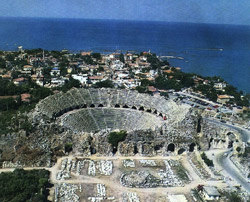Berkeleyan
Berkeley astronomers to participate in eclipse webcast
![]()
| 22 March 2006
On Wednesday, March 29, three Berkeley astronomers will take the stage in a 1,900-year-old Roman amphitheater in Turkey to introduce local students and the public to the science and lore of solar eclipses, just prior to a rare four-minute total eclipse of the sun.
| Where to view the eclipse (if you're
not in Ghana, Libya, or Mongolia) Avid Bay Area night owls can experience the eclipse live at all-night open houses at the Exploratorium in San Francisco and Oakland's Chabot Space & Science Center. The live webcast will start at about 1 p.m. Turkish time (2 a.m. PST) on March 29, with totality occurring at 2:55 a.m. Pacific time. (Sound sleepers can view the archived eclipse at www.exploratorium.edu/eclipse/2006 or sunearthday.nasa.gov.) |
For the benefit of eclipse watchers elsewhere in the world - including those in this region who are awake at 2:55 a.m. Pacific time - the eclipse will be webcast live as part of the yearly "Sun-Earth Day" celebration sponsored by NASA's Sun-Earth Connection Education Forum.
Berkeley research astronomer Nahide Craig helped organize the event in Side, Turkey, under the auspices of NASA's Sun-Earth Connection Educational Forum, an educational-outreach project co-directed by research astronomer Isabel Hawkins of Berkeley's Space Sciences Laboratory and James Thieman of NASA Goddard Space Flight Center.
Hawkins will co-anchor the 75-minute webcast with Exploratorium physicist Paul Doherty, drawing upon the expertise of Berkeley research physicist Janet Luhmann, principal investigator of the IMPACT instrument aboard the soon-to-be-launched STEREO spacecraft, and NASA Goddard educators. Craig, a native of Turkey and education manager of STEREO/IMPACT, will work the crowd. Also on hand to work with the local public and schools will be Ruth Paglierani, coordinator of public programs at SSL.
 The Roman amphitheater at Side, Turkey, near where Marc Antony once wooed Cleopatra. From the stage here, three equally passionate Berkeley astronomers will interpret next week's solar eclipse. |
The team plans activities in the days leading up to the eclipse - some of them podcast by NASA Goddard and the Exploratorium - including visits to local schools. The day of the eclipse they will set up telescopes in the amphitheater and distribute sun-safe eclipse glasses to the 2,500 people expected to crowd into the event.
The moon's shadow will first darken the Earth along the eastern shore of Brazil, then cross the Atlantic to make landfall in Ghana. It will continue moving northeast through Togo, Benin, Nigeria, Niger, Chad, Libya, and Egypt, cross the Mediterranean and enter Turkey, and end at sunset in northern Mongolia.

